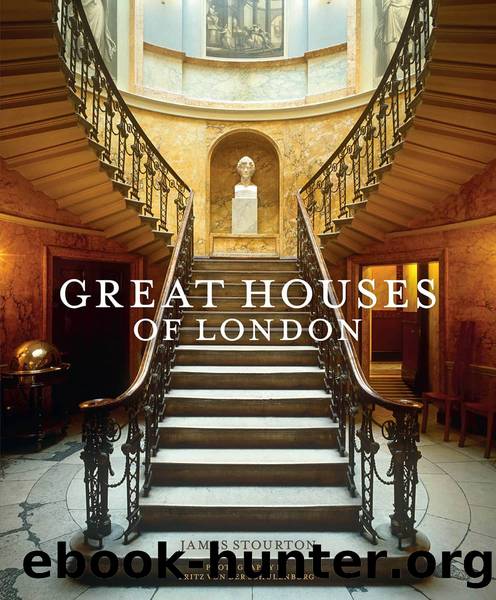Great Houses of London by Stourton James;von der Schulenburg Fritz;

Author:Stourton, James;von der Schulenburg, Fritz;
Language: eng
Format: epub
Publisher: Quarto Publishing Group UK
Published: 2022-05-15T00:00:00+00:00
The largest and most splendid block in the street was Nos. 18â19, an Italianate pair designed by the office of Charles Barry. Petoâs one-time partner, Grissell, moved into No. 19, but No. 18 had the more interesting residents. Baron Julius de Reuter, founder of the international news agency, occupied the house from 1868 until 1899. Viscount Lee of Fareham, who gave Chequers to the nation, lived there for five years from 1922, followed by the botanist/banker Lionel de Rothschild. By the 1970s, No. 18 was part of the Soviet Embassy, while the other half of the building, No. 19, was the Egyptian Consulate. In the early twenty-first century the houses were united for the first time by David Khalili and they are now occupied by a well-known Indian family. Only two of the four corner towers which make the house so distinctive are original; they lend a splendidly picturesque air to the composition.
One of the most distinguished houses in the street is No. 15, begun in 1854 by James Knowles for the rags-to-riches millionaire George Moore, who was shocked by his own vanity in possessing such a house. It became the scene of Christian missionary endeavour. Four hundred cab drivers were given dinner in the house and each presented with a copy of Bunyan. From 1937 the house was occupied by Sir Alfred Beit of the South African diamond family, who had inherited the fabulous art collection of his father, Sir Otto. He commissioned two fashionable architects, Lord Gerald Wellesley and Trenwith Wills, to design a rococo revival library, and a Palladian-rococo oval dining room to display the set of six Murillos of The Parable of the Prodigal Son. The rooms survive, but, alas, not with the contents, which were removed to Ireland. After the Beits, No. 15 became the Iraqi Embassy. It has now reverted to private occupation and is currently the subject of a major restoration. Beyond this the street turns into Palace Green, which was developed at the end of the nineteenth century.
The character of the street was always international. Figures such as Leopold Hirsch (No. 10), not to mention Reuter, Beit and Baroda, saw to that. By the 1980s the embassies had taken over but there are still enough privately owned houses for the street to maintain its other sobriquet of âMillionairesâ Rowâ. Uniformed guards monitor entrances and exits and today the experience of walking down Kensington Palace Gardens induces the melancholy that invariably hangs over the empty metropolitan houses of the very rich.
Download
This site does not store any files on its server. We only index and link to content provided by other sites. Please contact the content providers to delete copyright contents if any and email us, we'll remove relevant links or contents immediately.
| Great Britain | General |
| Bath | Devon |
| Gloucestershire | London |
| Yorkshire |
Spell It Out by David Crystal(35347)
Underground: A Human History of the Worlds Beneath Our Feet by Will Hunt(11256)
A Year in the Merde by Stephen Clarke(4652)
Venice by Jan Morris(2051)
Claridge's: The Cookbook by Nail Martyn & Erickson Meredith(1962)
My Paris Kitchen: Recipes and Stories by Lebovitz David(1893)
A TIME OF GIFTS by Patrick Leigh Fermor(1847)
The Plantagenets by Dan Jones(1615)
Welcome to the Goddamn Ice Cube by Blair Braverman(1601)
Bang Poland: How To Make Love With Polish Girls In Poland by Roosh V(1587)
Top 10 Prague (EYEWITNESS TOP 10 TRAVEL GUIDES) by DK(1567)
From Russia with Lunch by David Smiedt(1551)
The Finnish Way by Katja Pantzar(1535)
The Isle of Mull by Terry Marsh(1517)
A TIME TO KEEP SILENCE by Patrick Leigh Fermor(1499)
A Taste of Paris by David Downie(1491)
Rick Steves London 2018 by Rick Steves & Gene Openshaw(1490)
Merde in Europe by Stephen Clarke(1435)
Insight Guides Experience Tokyo by Insight Guides(1416)
